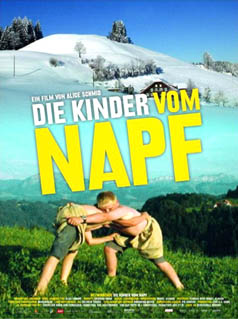
Starts October 25
Original language: Swiss German
 For 365 days director Alice Schmidt filmed children in their natural habitat in and around the mountainous Swiss town of Romoos, in an area called Napf. This lies at the onset of the Swiss Alps, one of the most rugged areas with beautiful walking trails but no roads or train tracks. The children live in an isolated paradise of hills, mountains, streams, valleys, ravines, and farmland. As Michaela (age 11) says, “Romoos is super. There is one bakery, one post office, and one school.” The film opens dramatically with five or six children stomping through high snow drifts, each with a miner’s light on his winter cap. They are on their way to the ski lift which will take them across the canyon to a school bus and then to their school in Romoos. School life is the same as anywhere else: reading, writing, arithmetic, with certificates awarded for excellence, and after-school activities such as music and sports. The children help at home and in the fields. They proficiently wield a hammer or a rake and steer the tractor. Surrounded by generations of relatives, they go to church and sing in the choir. They are rowdy, enthusiastic, humorous children who enjoy a life they share with animals: cows, donkeys, chickens, cats, mice, geese, sheep, etc. Boys and girls alike seem to enjoy wearing either one or two earrings, and in spite of the strenuous physical activity, some are as plump as sedentary kids in big European cities.
For 365 days director Alice Schmidt filmed children in their natural habitat in and around the mountainous Swiss town of Romoos, in an area called Napf. This lies at the onset of the Swiss Alps, one of the most rugged areas with beautiful walking trails but no roads or train tracks. The children live in an isolated paradise of hills, mountains, streams, valleys, ravines, and farmland. As Michaela (age 11) says, “Romoos is super. There is one bakery, one post office, and one school.” The film opens dramatically with five or six children stomping through high snow drifts, each with a miner’s light on his winter cap. They are on their way to the ski lift which will take them across the canyon to a school bus and then to their school in Romoos. School life is the same as anywhere else: reading, writing, arithmetic, with certificates awarded for excellence, and after-school activities such as music and sports. The children help at home and in the fields. They proficiently wield a hammer or a rake and steer the tractor. Surrounded by generations of relatives, they go to church and sing in the choir. They are rowdy, enthusiastic, humorous children who enjoy a life they share with animals: cows, donkeys, chickens, cats, mice, geese, sheep, etc. Boys and girls alike seem to enjoy wearing either one or two earrings, and in spite of the strenuous physical activity, some are as plump as sedentary kids in big European cities.
What they don’t have are televisions, cars, computers, iPhones or iPods/pads; there is no constant texting of messages. Their lives are much like those of German or American children in the 1950s, happy and satisfied with their lives and optimistic about the future. To my own astonishment, I thoroughly enjoyed every minute of this diverting documentary, over too quickly. You will, too, especially if you liked 20 Geigen auf St. Pauli or Die Thomaner, also about children in unusual circumstances.
